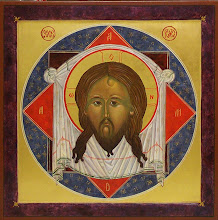
This icon is also known as, Simeon with the Christ Child. The story is told of the Presentation of Jesus in the Temple in the Gospel of Luke 2:25 - 32. We read that Simeon had been assured he would not die before he had seen the promised Messiah. When Mary and Joseph brought Jesus to the Temple after 40 days from his birth, as required by law, Simeon took Jesus in his arms and said, "Lord, now lettest thou thy servant depart in peace, according to thy word. For mine eyes have seen thy salvation, which thou hast prepared before the face of all people, to be a light to lighten the Gentiles, and to be the glory of thy people, Israel." These words have become part of Vespers in the Eastern church and Evening Prayer in the Western church. Simeon further prophesies in Luke 2:33 - 35, the future of Jesus and that a sword would pierce the heart of Mary.
The icon is 7" x 9" and written in egg tempera and gold on gessoed wood panel.


